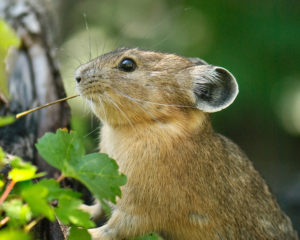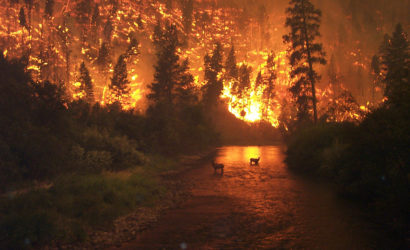We have much more to do and your continued support is needed now more than ever.
Climate Research Provides Insights into Wildlife Conservation

Climate change is having a big impact on many species, including the tiny American pika. Wildlife like the pika need new, accurate climate science, like the National Climate Assessment. This science enables wildlife managers to assess the impacts of climate change and determine how to best protect wildlife, and helps local officials prepare for unavoidable threats to vulnerable human populations. The assessment should also be heeded by federal policymakers and serve as the basis for new, aggressive action in Congress to prevent greater warming of the planet.
The National Climate Assessment is a collection of the most up to date climate science that can be used to inform sound policy and decision making to support wildlife conservation.

Designed to be “an authoritative assessment of the science of climate change,” the report undergoes a public comment period, a review by the National Academy of Sciences, and a final federal review. The report provides an overview of what we know about climate science, along with details on the regional impacts of climate change, and proposes mitigation techniques.
As part of the report’s release, the National Oceanic and Atmospheric Administration hosts weekly webinars by the National Climate Assessment’s contributing authors and researchers. Texas Tech University atmospheric scientist Dr. Katharine Hayhoe began the series with a discussion of recent developments in climate science and her perspective on the report’s major findings. Dr. Hayhoe has served as a lead author of the second, third, and now fourth National Climate Assessment. In addition to this work, Dr. Hayhoe shares her research on how climate change affects humans through the accessible and entertaining web series, Global Weirding.
For Dr. Hayhoe, the takeaway is simple: Climate change is not distant. In fact, “It’s real, it’s us, it’s serious; and the window of time to prevent widespread dangerous impacts is closing.”
The bedrocks of climate science are generally accepted by scientists and understood by the public. For example, climate change’s impact on the Arctic has served as our climate canary in the coal mine, and people across the globe have felt the impact of the increased frequency of extreme weather. Today, these topics are discussed with a high degree of confidence among climate scientists.

Looking forward, the only certainty is that we are in uncharted territory. As Dr. Hayhoe says, “We are conducting an unprecedented experiment with our planet.” For the first time in human civilization, we are on track to reach an atmospheric carbon dioxide level not experienced for tens of millions of years. At our current rate of emissions, we’ll fail to stay below the global temperature goal stated in the international Paris Agreement. The Paris Agreement’s long-term goal is to keep the increase in global average temperature to well below 2 °C above pre-industrial levels; and to limit the increase to 1.5 °C, since this would substantially reduce the risks and effects of climate change. These daunting facts tell us that we are on a dangerous and unpredictable path, putting ourselves at increased risk of climate impacts.
The negative effects of climate change are becoming increasingly visible. California’s recent heat wave is an example of what we can expect as global temperatures increase. With a 120° F peak during the day and nighttime temperatures as high as 82°F, California has experienced record-breaking heat this summer.
And it’s not just the overheating from high temperatures that impact people and wildlife. The heat wave caused unsafe air quality conditions for many Californians as dangerous ground level ozone increased, and set the perfect conditions for wildfires to ignite. Climate scientist and report contributor Dr. Michael Wehner’s recent study concludes that human activity increased the likelihood of the California heat wave by up to fifty percent and increased temperatures by 2-3°F.

Extreme precipitation is another visible effect of climate change. Higher average temperatures mean greater evaporation, allowing storms to release more water. For example, it is estimated that human-driven climate change increased Hurricane Harvey’s rainfall by 38%. The extreme rainfall from Hurricane Harvey impacted wildlife in many ways, but one of the most devastating examples was the flooding of Attwater Prairie Chicken National Wildlife Refuge, which harmed the already endangered prairie chicken.

Further, the probability of future Harvey-like storms is predicted to increase from 1% per year to a shocking 18% chance by the end of the century. These indicators tell us we are increasing the probability of both the occurrence of major events and their ability to inflict greater damage.
Some factors of climate change are not as well understood. For example, scientists are trying to solve inaccuracies in our assessment of ice sheet stability. Recent discoveries have been used to understand and account for all of the ways ice is affected. This research led to increased projections for the upper limit of sea level rise and adjusted accepted ice melt projections.
With new data, scientists now forecast that the sea level could rise up to eight feet in high carbon scenarios. New findings like these allow us to better understand the recent decline in coastal real estate prices.

According to Dr. Hayhoe, a recent study states that coastal home prices in the United States have already dropped by 7% in anticipation of the projected rise in sea level.
It is this intersection of climate change and human activity that will be the focus of the Fourth National Climate Assessment.
Dr. Hayhoe’s discussion presented new discoveries in climate science and suggested how this new information sheds light on areas not previously considered by climate scientists. If there is one thing that science is telling us, it is that climate change is no longer an issue for the future, but something that is very much affecting our lives today.
Many mayors and governors are rightfully concerned about the implications of a warming planet for their constituents, economies, and natural resources. The U.S. Climate Alliance of states is taking steps locally to adhere to commitments the U.S. made under the Paris agreement, as well as over 400 U.S. “Climate Mayors.” As remarkable and needed as their actions are, the climate crisis cannot be averted without action by our federal government, guided by the scientific findings of the National Climate Assessment and leaders like Dr. Katharine Hayhoe.
Take Action: Tell your Senators and Representatives in Congress to act boldly on climate change, to protect vulnerable people and wildlife, like the American pika.
Take ActionThank you to Mollie Carroll, guest writer for our Climate & Energy program.





















